FUNDAMENTALS A Complete Guide for Beginners

In Bash, the read command is commonly used for taking user input. Interestingly, it allows the scriptwriter to take pause and wait until the user enters some input or presses any key. Moreover, one can set a timeout using the -t option. We can even take different actions based on different inputs provided by the user. We are going to explore waiting for input Bash and how to effectively utilize this in Bash scripting.
4 Practical Examples of Waiting for User Input Using Bash Script
The read command is the default choice for taking user input in Bash scripting. In the subsequent examples, we are going to discuss how to use the read command to wait for user input and discuss their applications in detail.
1. Wait for Input With “timeout” in Bash
This example demonstrates a Bash script that waits for user input while providing a time limit for response. The script allows users to terminate the program by pressing any key on the keyboard within a 5-second period. Here’s a bash script to wait for input with timeout:
#!/bin/bash
echo "Press any key within 5 seconds"
# Loop until a key is pressed or 5 seconds have elapsed
while true; do
read -t 5 -n 1 key # Read a single character within a 5-second
if [ $? = 0 ]; then
echo -e "\n$key is pressed. Program Terminated"
exit # Exit the script if a key is pressed
else
echo "Waiting for a keypress"
fi
doneHere, the The echo command displays the message “Press any key within 5 seconds”. Later an infinite while loop starts that will continue until explicitly terminated.read command is used to read a single user input within 5 seconds. The script checks the exit status using $?. If the exit status is 0, it means that a key was pressed within the 5-seconds timeout and the program terminates displaying the message “$key is pressed. Program Terminated”. If the exit status is not 0, the echo command is used to display the message “Waiting for a keypress”. Finally, the loop continues, waiting for a keypress or until the 5-second timeout is reached.

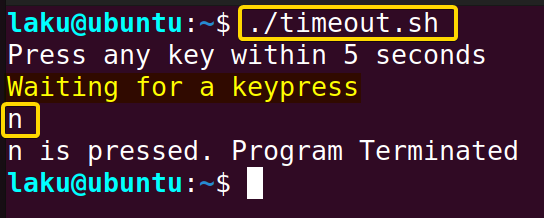
2. Wait for Pressing Any Key in Bash script
This example discusses a Bash script that waits for user input and terminates only when the user types any key in the keyboard. Open a file named anykey.sh & write the following script in the file to wait for user input:
#!/bin/bash
echo "Press any key to terminate the application..."
# Loop until a key is pressed
while true; do
read -rsn1 key # Read a single character silently
if [[ -n "$key" ]]; then
echo "One key detected. Program terminated."
break # Exit the loop if a key is pressed
fi
doneThe echo command displays the message “Press any key to terminate the application…”. Later an infinite while loop starts that will continue until explicitly terminated. When a key is pressed, the break statement immediately breaks the loop thus terminating the application.

3. Wait for Pressing Specific Key in Bash script
Like waiting to press any key, we can write a Bash script that waits for specific input from the user. For instance, the script of this example terminates its execution only when the user presses q. Open a file named specifickey.sh & write the following script to wait for specific user input:
#!/bin/bash
echo "Press the 'q' key to quit..."
while true; do
# Read a single character from the input
read -n 1 key
# Check if the pressed key is 'q'
if [[ $key == "q" ]]; then
echo -e "\nProgram is Quitting..."
break
else
echo -e "\nPlease press q to exit."
fi
doneThe echo command displays the message “Press the ‘q’ key to quit…”. Later an infinite while loop starts that will continue until explicitly terminated. The read command is used to read a single input from the user and store the input in a variable namely key. The program terminates if the value stored in key is q. Otherwise, it prints “Please press q to exit”.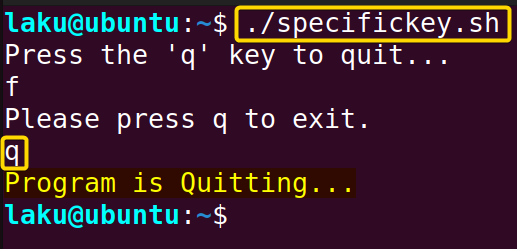
4. Wait for Inputting Specific Key with “timeout” in Bash
This example discusses how we can terminate the execution of a script within a time limit. The program waits for the user to input a specific key to terminate the execution. However, if the user is reluctant to terminate the program inputting that specific key it deliberately terminates itself automatically.
Check the bash script to wait for inputting specific key with timeout:
#!/bin/bash
echo "Program will terminate automatically after 5 seconds."
echo "Press Enter to terminate immediately."
read -t 5
read_exit_status=$?
if [ $read_exit_status = 0 ]; then
echo "You pressed Enter. Program terminated."
else
echo "Timeout occurred. Enter key was not pressed."
fiThe echo command displays the message “Program will terminate automatically after 5 seconds.”. Later the read command is used to read a single input from the user within a 5 seconds timeout. $read_exit_status is equal to 0 indicating that enter is pressed within the timeout. So the program terminates before reaching timeout. Otherwise, the program terminates itself automatically when it reaches the timeout of 5 seconds.
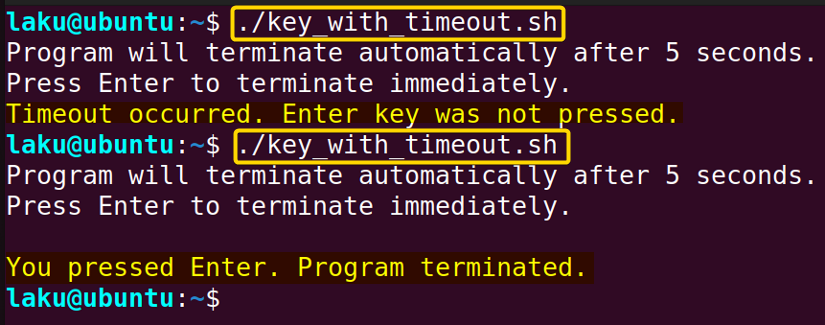
2 Practical Applications of Waiting for User Input Using Bash Script
Bash waits for user input and has many real-life applications. This article delves into the creation of interactive menus and the implementation of user confirmation before executing critical actions. Waiting for user input is the central part of the execution of these applications.
1. Creating Interactive Menu Using Bash Script
In this application, we utilize Bash to create a restaurant menu that waits for user input. Users are presented with four different food items and have the option to select a menu item from the available choices. Here’s a bash code to create an interactive menu to wait for user input:
#!/bin/bash
echo "Program will terminate automatically after 5 seconds."
echo "Press Enter to terminate immediately."
read -t 5
read_exit_status=$?
if [ $read_exit_status = 0 ]; then
echo "You pressed Enter. Program terminated."
else
echo "Timeout occurred. Enter key was not pressed."
fiIt reads the user choice while displaying the message “Enter your choice: ” . The case statement offers the user the option of choosing one from different food items. If the user chooses a valid input the program terminates immediately otherwise it displays “Invalid choice. Please try again.” and prompts the menu again.
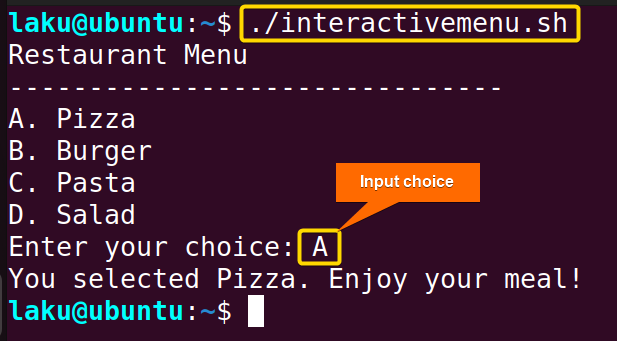
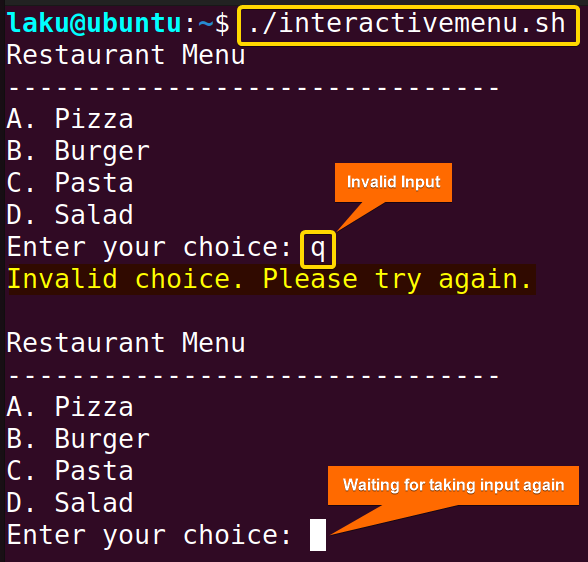
2. User Confirmation Before Critical Action in Bash Script
User confirmation is crucial for major tasks. It adds an extra layer of protection, ensuring users can prevent unintended consequences. For example, before installing potentially risky applications, obtaining user confirmation helps to avoid potential harm to the system and data.
In this Bash script, we create a program that takes user confirmation before deleting all the empty files of the current directory. Open a file & write the following script to accomplish this task:
#!/bin/bash
echo "This script will delete all empty files in the current directory. Are you sure you want to proceed? (y/n)"
while true; do
read -s -n 1 key
case $key in
y|Y)
echo "Deleting empty files..."
find . -type f -empty -print -delete
echo "You pressed $key. Empty files deleted successfully."
exit 0
;;
n|N)
echo "You pressed $key. Operation canceled."
exit 0
;;
*)
echo "Invalid input. Please press 'y' or 'n'."
;;
esac
doneIt then echoes a message stating that it will delete all empty files in the current directory. At this point, the program waits for user confirmation. If the user presses ‘y’ or ‘Y’, it signifies their intent to proceed. The script executes the find command within a case statement, which deletes all empty files in the current directory. The operation of deleting empty files cancels if the user presses ‘n’ or ‘N’. If the user inputs any other keys, an error message is echoed, indicating invalid input.



Conclusion
In conclusion, waiting for input in Bash scripts has many practical applications. In some cases, it is important to take input from the user for further execution of the script. Even it may be crucial to continue if the user delays giving input. Hope this article helps you to understand all the basics of implementing how to wait for input in Bash.
People Also Ask
How to pause execution and wait for user input?
The read command can be used to pause execution and wait for user input. -t option of read command is useful to pause a script. -t by default takes second as unit of timeout. The sleep command can also be used for similar purposes.
Wait for complete a background process or user input to terminate?
To terminate a background process based on user input kill command can be used. The read command can take user input. By detecting the input the kill command can terminate the background process.
How to exit if nothing is given in the input wait part?
The easy way to exit if nothing is given in the user input part is by adding a exit statement just after the input section.
Related Articles
- How to Use Input Argument in Bash [With 4 Practical Examples]
- How to Use Bash Input Parameter? [5 Practical Cases]
- How to Read User Input in Bash [5 Practical Cases]
- How to Read CSV Files in Bash? [2 Methods]
<< Go Back to Bash Input | Bash I/O | Bash Scripting Tutorial




Example 4.3 says
3. Wait for Pressing Specific Key in Bash script
For instance, the script of this example terminates its execution only when the user presses q.
Code has: echo “Press any key to terminate the application…”
Explanation has: The echo command displays the message “Press the ‘q’ key to quit…”.
Code does not match explanation 😉
Hi Earl, Thanks for pointing out the mismatch. I have updated the misplaced code and sorry for your inconvenience. Feel free to reach us with your queries about Linux related topics. We are happy to help you. Keep reading. Cheers…
Thanks for a clear and complete explanation with examples. I find most other “helpful” articles to be just the opposite. Good work!
Thanks for your good words. Our motto is to help users with concise examples that clears most of the confusion. Keep exploring our articles and never forget to give a compliment if it is helpful.